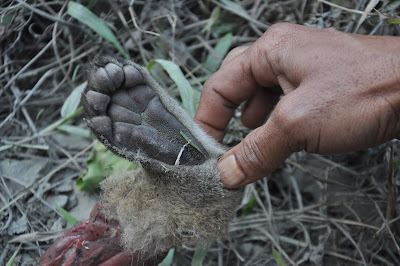Four (ignorant) men and a Civet
On a lovely late winter morning four of us
were moving within the Dampa Tiger Reserve when we stopped to observe the possible
contours of a proposed ‘development’ action. This was between Phaileng and
Phuldungsui (appx 250 mtrs before the Varihaw anti poaching
camp) near Keipuizel (place where - years
ago - tiger has been sighted crossing the road).
As I enjoy - doing in Mizoram - I took one kuwa (betel-net) and began loitering up and down the winding road. All of a sudden my eyes fell on a carcass. I excitedly requested others to join. We clicked images (with the photographer and carcass in varying positions), tried to measure the carcass, made attempts to put the ‘mammal book’ and note-pad to good use yet were not sure on exact species.
But, like the proverbial four wise men who had
come across the elephant, we had observations and questions on the carcass.
First the questions:
Was it a road kill?
Can this have been eaten by a Clouded
Leopard (Kelral)?
Was the predator carrying it across the
road?
Why is the tail not eaten?
How is the rib cage intact?
Then the observations:
Claws on one paw: 5 (and white on the inside)
Eyes: White between eyes
Ears: Bat like
Whiskers: White
Length: 4feet 1inch (nose to tail)
And now some (basic) facts of the species which
Anwaruddin Choudhury in his The Mammals of North East India says of the species in Mizoram
“Rarer than other areas of the region. Recorded from the north near interstate border with Assam. A specimen in ZSI from Darlak, c. 50km NNW of Aizawl obtained in 1984. Also since at Sairep in Lunglei district (Mandal et al. 2007)
Vivek Menon in his Indian Mammals - A Field Guide states of its behaviour “Skunk like, it ejects a foul-smelling liquid when disturbed” and of its habitat “Evergreen and deciduous montane forests and near human habitation (up to 2,500 m)
Thanks are due to Anwaruddin Choudhury for helping identify the species, Zakhuma Don for clicking and sharing the images, Forest Department of Mizoram for helping during the trip and Oriental Bird Club for enabling the trip.




Comments
Post a Comment